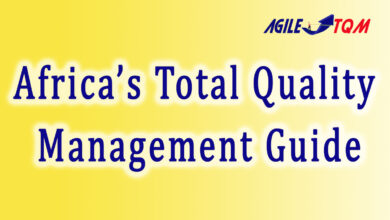Origin of Total Quality Management

TQM definition
Different definitions are proposed in the literature in order to define Total quality management, (Jea Yu Park & Hong (2017), Hellsten and Klefsjö (2000)). Hellsten and Klefsjö (2000) qualify these definitions as being vague and unable to cover this wide concept. In fact, the existence of similar concepts as Total quality control, Total quality improvement, and strategic quality management creates confusion.
TQM definition 1: Total quality management describes a management approach to long-term success through customer satisfaction. All members of an organization participate in improving processes, products, services, and the culture in which they work. Therefore, Total quality management is a set of principles and tools or a philosophy that represents a continuously improving organization, (Jea Yu Park & Hong, 2017).
TQM definition 2: Total quality management is a continuously evolving management system consisting of values, methodologies and tools, the aim of which is to increase external and internal customer satisfaction with a reduced amount of resource, Hellsten and Klefsjö (2000)
TQM definition 3: “Total quality management (TQM) consists of organization-wide efforts to install and make a climate where employees continuously improve their ability to provide on demand products and services that customers will find of particular value”, Ciampa (1992).
Quality Gurus
The concept of total quality management was inspired by Armand V. Feigenbaum and Kaoru Ishikawa and W. Edward Deming. They were the first to develop the total quality concept, however the exact origin of the concept is not certain, it dates back to quality evolution in Japan after World War II.
Starting from 1940, companies in Japan started to apply total quality management. Initially, manufactured products in Japan were cheap, imitations and have low quality. Japan quality gurus like Armand V. Feigenbaum and Kaoru Ishikawa and W. Edward Deming were invited to provide a plan. At that time, their suggestions and advice had been applied in Japan and Japanese companies and they witnessed results in ten years. Consequently, Total quality management became part of Japanese firms culture. TQM application in Japanese firms leads to higher quality of manufactured products and reduced costs, Powell T. (1995). Companies applying Total quality management achieved processes improvement, waste reduction and time saving, Tubagus A. (2019). At the same time, customers have cheaper and higher quality products. Japanese firms applying TQM are able to reduce variability and this improves customer satisfaction and loyalty. TQM leads also to employee commitment, (Ahmad M et al. (2014), Pheng L. (2001)).
In 1980, western companies inspired by the Japanese achievement, started the implementation of Total quality management practices. These companies are interested in these methods in order to improve their processes. Japan at that time was moving from a military country to an industrialized one, however their products are reputed to be of poor quality. Japanese companies saw the need to improve quality in order to be competitive, and they saw in Juran the right person to help them reaching their goal.
Japan has seen at that time the development of many industrial groups such as Nikon, Takeda pharmaceutical company, Noritake and Showa Denko a chemical group. These companies have been pioneers in terms of the introduction of quality and innovation. Total quality management was very present in Japanese firms, especially after the development of quality improvement by W. Edward Deming and his contribution in Japanese firms. W. Edward Deming was invited by Japanese to lecture on the topic of total quality management they already use Shewhart’s methods of statistical quality control. Deming highlights the lack of participation of workers in quality control in the USA during the World War II. Management and engineers control all the process. W. Edward Deming idea was to participate workers in methods of statistical control and he found that Japanese companies are very receptive to his idea. Hence, Japanese companies are the first to implement the total quality management principles, (Ahmad M et al. (2014), Powell T. (1995), Tubagus A (2019), Pheng L. (2001)).
After the use of Total quality management, product quality in Japanese firms has seen an improvement and Japanese firms witnessed an increase in their exports. Subsequently, US firms followed the trend and adopted the total quality management principles in their processes.
Shewhart is another quality Guru known as the father of Statistical process control, which is a set of statistical tools to control a process. Shewhart worked for Bell telephone and his assignment was to improve the voice clarity of the carbon transmitters in the company’s telephone handsets. He used statistical methods in different departments, then to the whole company. Shewhart joined later a Western Electric inspection department, when he joined the company quality consists only on inspecting finished goods. Shewhart applied in Western electric Statistical process control methods like control charts. Shewhart came up with different methods and ideas like reducing variation in the manufacturing process. Shewhart’s work caught the attention of Edward Deming. They collaborated during world war about productivity. Deming promoted Shewhart’s ideas in Japan and developed Shewhart cycle also called Deming cycle, Bayart D. (2005).
Deming used the work of Shewhart and promoted his ideas in Japan, like Statistical Process Control methods, Shewhart Cycle also called Deming cycle. Deming is the leader of change of Japanese industry post World War II. Japan became later the second strongest economy. Deming thus spent a lot of time learning Shewhart’s ideas and preparing his training course for Japanese companies using Shewhart’s methods and adding his own touch. Deming’s contribution to the Japanese economy was that improving quality would reduce expenses while increasing productivity and market share. Consequently, many Japanese firms used his techniques and witnessed a lot of improvement in quality and productivity. This improvement in quality and reduction in costs put the Japanese products in the highest demand. In recognition of the quality of his work, the Deming prize was established. This Prize represents a high contribution to quality management and quality control.
In the US, Deming was still not famous, he was running his consultancy business until Ford motor started using his methods in 1981, it was one of the first US companies to use his methods. Deming was hired by Ford to improve quality witnessing at that time a lot of losses and a decrease in sales. Deming spoke about management instead of quality. Deming states that management is responsible for 85% of the quality problems in products. Just after, Ford became the first car manufacturer, and profits exceeded those of Chrysler and GM.
- Establish constancy toward continuous improvement;
- Management has different challenges, they have new responsibilities;
- Less inspection to achieve quality;
- Cease dependence on inspection to achieve quality;
- Reduce costs, build partnership with suppliers
- System of production Continuous improvement;
- Provide training at work;
- Leadership helps people and machines;
- Eliminate culture of fear so people can work effectively;
- Create synergy between departments;
- Target zero defects and reach new levels of productivity, all employees take initiatives and apply their ideas;
- Supervisors should focus on quality rather than numbers, No more management by objectives;
- Set a program of education and self-improvement for employees;
- Everybody in the company takes part in the transformation.
References
- Hellsten, U., & Klefsjö, B. (2000). TQM as a management system consisting of values, techniques and tools. The TQM magazine.
- Yu, G. J., Park, M., & Hong, K. H. (2020). A strategy perspective on total quality management. Total Quality Management & Business Excellence, 31(1-2), 68-81.
- Ciampa, D. (1992). Total quality: a users’ guide for implementation. Addison Wesley Publishing Company.
- Powell, T. C. (1995). Total quality management as competitive advantage: a review and empirical study. Strategic management journal, 16(1), 15-37.
- Tubagus, A. D. (2019). Total Quality Management (TQM) for Japanese Companies and Their Implementation in Companies in Indonesia. Pathumthani University Academic Journal, 11(2), 213-231.
- Juran, J. M. (2004). Architect of quality: the autobiography of Dr. Joseph M. Juran. McGraw Hill Professional.


